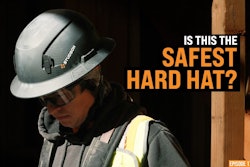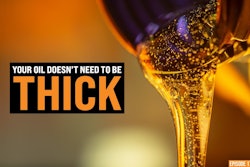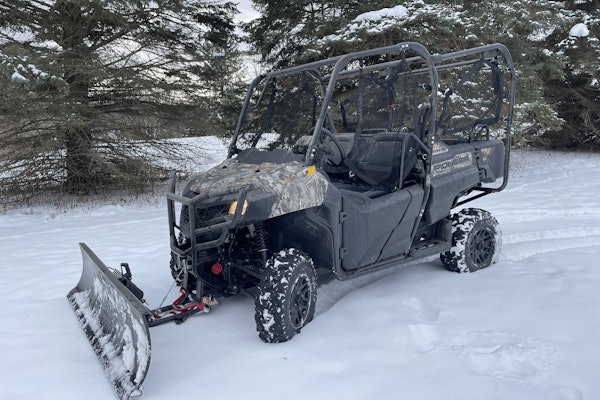Small contractors often think of oil sampling as something for the big construction companies.
But what they don’t know is that it costs a lot less than they might think.
On this episode of The Dirt, Chevron Lubricant’s Shelly Eckert explains how contractors of any size can use this important, cost-saving diagnostic tool. She explains the ins and outs of oil analysis – including how much it costs and how to do it – and what all heavy equipment owners and operators should know.
She likens it to going to the doctor and giving a blood sample. The purpose is the same – checking the health of your equipment.
“When you start looking at the cost of it, you need to look at the return on investment,” she says. “It is an investment.”
And it’s an investment that can save you lots of equipment downtime.
So, if you want to keep your equipment running for longer and in top condition, check out the latest episode of The Dirt.
Equipment World serves up weekly videos on the latest in construction equipment, work trucks and pickup trucks – everything contractors need to get their work done. Subscribe and visit us at equipmentworld.com!
In This Episode
- 00:00 Oil sampling
- 01:18 How much does an engine oil sampling program cost?
- 02:24 Annual spending for engine oil analysis
- 03:51 Cost of engine oil analysis vs cost of equipment
- 05:16 Benefit for smaller contractors
- 06:40 What ROI can be expected?
- 08:26 Reasons to sample engine oil
- 11:54 Does personal history make a difference
- 12:40 Break-in wear on equipment
- 13:51 Older equipment and engine oil sampling
- 16:08 Using a high-quality lab
- 17:08 Summing up engine oil sampling
Bryan Furnace:
Today we're back to talk about oil sampling some more, but I want to come at it from the angle of really how expensive is this and what sort of return can you expect on your investment? Is oil sampling really worth it for the small guys in the industry or is this something that's only made for companies with really large fleets? Here from Chevron is Shelly Eckert again, and she's going to dive into this with us and give us some information about oil sampling and why it's applicable to the small guys as well. Well, Shelly, thank you so much for coming back on the dirt. It's so good to see you again.
Shelly Eckert:
It's a pleasure to be here. Thank you for having me.
Bryan Furnace:
Absolutely. It's always a treat. So this week, instead of talking about coolants, we're going to switch it up and we're going to go back to talking about oil sampling. And as I talked with the audience about in the intro, we've kind of come at oil sampling at a very high level in previous interviews, and we've kind of talked in generalities about an oil sampling program Today. I really kind of want to take it to the granular level and really home in on what an oil sampling program would look like for boots on the ground people. And so my first question is, realistically, what is an oil sampling program going to cost me per year? Is this an additional expense that I have to worry about and then worrying about making up for it on the backend, or is this something you can get into pretty affordably?
Shelly Eckert:
I think you can get into it pretty affordably when you start talking about how you calculate the cost of the oil analysis. And sometimes the cost of the testing can look like it's, Ooh, this lab is really inexpensive, but this lab over here is much more expensive. Well, that could also be the quality of the two laboratories. When you start looking at the cost of it, you need to look at the return on investment. It is an investment. If you start looking into that factor of how much does it cost you when the piece of equipment is down and it's not working, which means it's not making money, how much does the parts to replace the part when there's a failure, the labor cost to make that repair? And the timing, it could be not planned at all, and then you have to scramble. But if you're doing oil analysis, that is actually should be built into this cost. So you're sending the sample into the lab and it's like when you go to the doctor, you take a blood sample and the doctor comes back with, oh, you've got good cholesterol, or you have bad cholesterol, or you are lacking iron. Well, that's the same thing as sending a sample of an oil sample into the lap, checking the health of the equipment.
Bryan Furnace:
That sounds great. And I do personally, I totally agree with everything you've just said, but I'm also very well versed with all the old salty dogs in the industry that change oil every X amount of hours the way we've done it, grand Pappy's time. And why am I going to pay for this newfangled oil sampling? Realistically, what ballpark numbers, I know there's going to be some variance, but ballpark numbers. What am I going to spend a year in sampling equipment and sending my samples off to a lab? Are we talking thousands of dollars?
Shelly Eckert:
It depends on how many sampling points you're taking. If you're sampling everything on yellow iron, it could cost you some money. But when you're talking about the return on investment, it's typically anywhere between $20 to one sample or $54 to one sample. And then again, that all depends on the factoring of what you're putting into determinant because upper management's going to want to know, are the owner operators going to want to know how much is this going to cost me? Right? In reality, it's saving you money, being preventative and predictive,
Bryan Furnace:
That kind of actually. So it's going to cost me roughly 20 to $50 a sample to send in. And for a smaller company, we may have two or three pieces of equipment, and you're going to do maybe a couple oil changes a year at most. So realistically, you're talking probably less than $500 for a couple pieces of equipment. And if you swell your fleet a little bit, you're still probably around a thousand to $1,500 mark. I mean, isn't, we're not talking a tremendous expense to set up an oil sampling program, especially if we're only talking oil sampling. Correct?
Shelly Eckert:
That's correct. It's just not, if you're looking at the, you start with how expensive is that piece of equipment? Because those big dump trucks in those mines when you look like a little people from we played when we were kids with the Tonka truck. That's in reality, when you're down those mines, those wheels are taller than me. So that piece of equipment's not cheap. So if you are looking and doing oil analysis, you could prevent a failure with not having that piece of equipment go down. Now, I will say there are spontaneous failures. So when you take a sample and you see metal shavings in that sample, you better find out what's wrong. It's already too late. The lab, when they look at samples and when they look at the metals, the metals are measured by a small piece of your hair. So it's stuff that you can't see visually in a sample unless it's really bad.
Bryan Furnace:
So where I go with that is I do think that the mines and a lot of these larger companies, I think they've really started to understand and grasp the concept, especially when you're talking about a multimillion dollar piece of equipment. 50 bucks is a drop in the bucket to be able to make sure that thing runs well, and to squeeze a little bit of extra life out of 50 gallons of oil in one of those huge engines. That's a thing. But I guess where I go is for small guys, it's these companies that may only have a couple pieces of equipment. Why do I need to worry about this? Why is this a big deal and why should I even spend 50 extra additional dollars on this program?
Shelly Eckert:
Well, you kind of just hit upon it. So if you are not doing oil analysis, you are missing, again, the health of the equipment. And it's not just the health of the equipment, it's making sure that piece of equipment is up and running. If it's down, you're not making any money, you're not digging, you're not doing anything. It could be on a job site when it goes down and then you have to get it back to the shop, then you've got a hauling expense. So there's all these things that can add up besides the parts and the labor that can build to this return on investment of doing the oil analysis. And then you're being more proactive versus reactive because essentially what you're doing, if you're not doing oil analysis, you're going to be doing reactive maintenance, not proactive maintenance.
Bryan Furnace:
And that kind segues me into my next question there, which is what kind of ROI can someone expect on an oil sampling program? And I guess that's kind of hard to pin down just because the return is actually so massive compared to the expense of doing the sample.
Shelly Eckert:
The return is very much bigger return by doing the oil analysis. But the labs have these calculators, and some of them are more complicated than others, but the labs would work with even an owner operator to figure out, how much am I actually going to save by spending this money? But it is going to be total number of a piece of equipment. What are you sampling the parts cost for a failure? The labor cost for failure, as I've said before, loss of reduction, all of that gets added in a cost of production. And then you just subtract the cost of the oil sample out and there's your savings by doing one oil sample that's cheap.
Bryan Furnace:
So let's do some very, very high level math here. …
Let's say on the high end, we're paying $50 a sample, which I think we can both agree that's going to be on the high end. It's not going to cost you typically $50 a sample to send in. And let's say we're doing 10 samples a year on our one machine, so we're spending $500 a year on our oil sample program for our one machine. It would take four or five years of oil sampling to equate what I'm going to spend just in parts and labor to get some sort of a large engine failure fixed on my machine. And I guess that's kind of where I go from a logic standpoint for a lot of these small guys is they're going, well, that's just a totally unnecessary expense. But when you really think about it over the course of, again, $50 a sample that's on the high side, we're doing it 10 times a year, which no contractor is going to do an oil sample 10 times a year on their piece of equipment.
So that's already an overinflated cost. But if I have to put my machine in the shop because it had some sort of an engine failure where we've got a valve issue bearing issue, you've got something going on with one of your sleeves, I mean, it's just that's going to be large money. You're probably seven to $10,000 on those repairs. You're still not even close to touching what you spend on the oil sampling program, which could have prevented this massive problem and you putting the machine in the shop and all of the downtime that it's associated with it.
Shelly Eckert:
So I'm going to counter that with a question. In your ICE's environment, you're moving dirt around, right? Yep. If you ingest dirt, what does that do to your engine?
Bryan Furnace:
It's abrasive and it's going to wear stuff out,
Shelly Eckert:
And it's going to wear it out, and the lab can detect that with running tests on it before it becomes a failure.
Bryan Furnace:
And so how often would you recommend sampling your oil a year to prevent that sort of an issue?
Shelly Eckert:
I would sample it every sample drainer, right? And if the lab comes back with an abnormality or severity, then I would reduce the drain interval and re-sample. First of all, look to see if there's proactivity or anything that they can do to fix the problem, but then re-sample it half the drain interval just to make sure that the problem was resolved. The first priority when you're looking at the health of the equipment is you want to keep it clean and free of contaminants, fuel dilution, coolant contamination, and of course dirt. And you guys, you've got, for example, caterpillar and John Deere are huge proponents of particle count cleanliness. Keeping that oil clean and requirements of being clean is you can't get that until you send it into the lab to understand if you're keeping clean. Now, the other thing about this is the fact that it's not just elongating the life of the equipment. If you were to go and want to resell that equipment, you could use the oil analysis to show that you were taking care of that equipment to increase the value of that equipment.
Bryan Furnace:
That's another good point, is help
Shelly Eckert:
Resale, which another reason,
Bryan Furnace:
Yeah, I guess counter
Shelly Eckert:
Or finding warranty claims. Oh,
Bryan Furnace:
I guess that's true too. I didn't even think about warranty claims and the fact that you can back up that you've been doing the appropriate maintenance, not he said, she said it's no, here's the legitimate documentation that we've been doing, oil sampling. Everything's been above board up until this point.
Shelly Eckert:
Yes.
Bryan Furnace:
How much does personal history make a difference versus, we've talked about it in the past, but for those who aren't familiar, these sampling programs, you're amassing data from across the entire globe, but more specifically just within the United States, they're amassing these huge quantities of data on these machines and the oil and the wear that's going on. And so to counter another argument of in my mind, well, we haven't been doing oil sampling and my machine's five or six years old. There's no point in starting now. How much does personal history matter versus the overall industry data? Can I still benefit on my five-year-old machine by starting an oil maintenance or an oil sampling program now versus when I buy the machine?
Shelly Eckert:
That's a really good question. So when you buy the machine, you're still dealing with break and wear. And if that break and wear is abnormal, you would not know it until there's a failure because there isn't, especially when the componentry has changed with new technology, they do all the testing, but when you actually get it out in the field, that's a totally different thing. So the lab will flag it if it's abnormal, break-in too, which helps, especially with wear. And then there's also, if you wanted to start five years into it, then the labs look at data, not just based on the hours on that oil, but they also look at the hours on the equipment and they're going back and forth and looking to see if the piece of equipment is older. It's going to be tolerable of more wear trends versus a newer piece of equipment or half two years into it. This is not rocket science, but it gives you a ton of information on that equipment, which is why you have the oil analysis programs all over the place for Caterpillar and John Deere and Komatsu and the lubricant companies. We all have our own oil analysis program. The filter companies had their,
Bryan Furnace:
How much will oil sampling benefit an older piece of equipment? And when I say older, I'm talking like 19 90, 19 85. If I've got an old dozer out back, is that one that we just kind of put it out to pasture and go, this is not going to really benefit this piece of equipment. It's just too old for this to really make a difference, or do the labs actually have data on those machines as well that it would be worth throwing some samples in there just to extend the life of this dinosaur? I mean, that's really where I go, is that need more maintenance.
Shelly Eckert:
Yes. But you've also, do you need to routinely sample that older piece of equipment? No. You could probably get away with maybe once a year doing a health check, or you've got, I hate to say this because it's not scientific. You got a new noise going on, just take a sample and send it to the lab and one sample a picture in time. So a lot of the oil analysis is done based on trend analysis. So once you get past that first couple of samples, then you're looking to see, when I diagnose samples, I start with, when was it last sampled? When is it currently sampled? How many hours are on the oil today? How many hours are on the equipment? And then I start looking at the data and I'll use OEM limits, or I'll use statistically derived limits now that I'm not in the field diagnosing samples anymore. How I do it now is I'll get a report and I'll look at the age of the equipment and the age of the oil, and then I will look at the commentary, and then I look at the what's flagged, right? I will admit there's times where I disagree with the diagnostics comments, but there's nothing wrong with sending it back to the lab and asking questions because predominantly we use production labs. The reason why we use production labs is to keep the cost of the oil samples down. Now, if there was any questions on the oil sample, there's always, what I would recommend is Southwest Research, they have an oil analysis lab, and that's often used as a referee lab by these big production laboratories.
Bryan Furnace:
Interesting. So they're kind of the standard that everyone holds everything up to compare.
Shelly Eckert:
Yes and no. I mean, there are round robin samples that go through the laboratories to check the consistency between all of the labs. Cummins has an onsite lab as well, but it's all about data extraction and data comparison. It's that the OEMs will go to the production laboratories to extrapolate data so that they can statistically analyze their performance by make and model and component, so they see value in it, but we have to feed them that data. Now, when that's done, there is no customer information provided. There's no traceability as who the customer sample it is. It's literally just the sample data and the make the model. And if we have it, because that goes back to a good solid oil analysis program. You have to give the lab, the make, and the model of the component, not the tractor, the component.
Bryan Furnace:
So to kind of summarize what I've learned today, it sounds like, first of all, this is not some cost inhibitive thing. It's not something that you got to start setting money aside for in your maintenance program. We're literally talking for one piece of equipment. You're easily less than $500 a year. When it comes to the actual sampling itself, more personal history, obviously is far better because it allows the labs to do the trend analysis. But at the end of the day, don't let that stop you from starting oil analysis on your five-year-old machine tomorrow, because it's still beneficial. And you're now starting that trend analysis even though your machine is already five years old. Did I kind of interpret that all correctly?
Shelly Eckert:
Yes. So for example, 40% of engine failures are coolant maintenance problems. And if you're not testing it, you're not going to see it. Those engines get so hot that if you thought maybe a visual of a milky color would tell you that you've got coolant, that's not necessarily the case. You could be down in Florida and have adjusted water, or you've just gone through a hurricane and you went ingested water. But generally speaking, the water in production will burn off the water and leave the chemical components. The salts, sodium and potassium are a combination of the two that clearly indicates to the lab, this is a cool leak, and they'll flag it that way.
Bryan Furnace:
Interesting.
Shelly Eckert:
And then you have to go find the source.
Bryan Furnace:
Yeah, exactly. But at least now you know that there's a problem that you wouldn't have known otherwise.
Shelly Eckert:
That's correct. Because a lot of times, if you'll change the oil, that cool leak will go away for like a hundred hours maybe, but it'll slowly accumulate back if you haven't fixed the problem.
Bryan Furnace:
Well, Shelly, thank you so much for all of the information, and thank you for, I mean, you're just a wealth of knowledge, and every time you come on here, it's like, okay, I'm learning a little bit more. Well, thank you again for Shelly taking the time to come on the show and really dive into some of the more gritty details of oil sampling and how it can benefit smaller companies like yours and mine. As always, I hope this helps you and your company. We'll catch you on the next episode of The Dirt.










